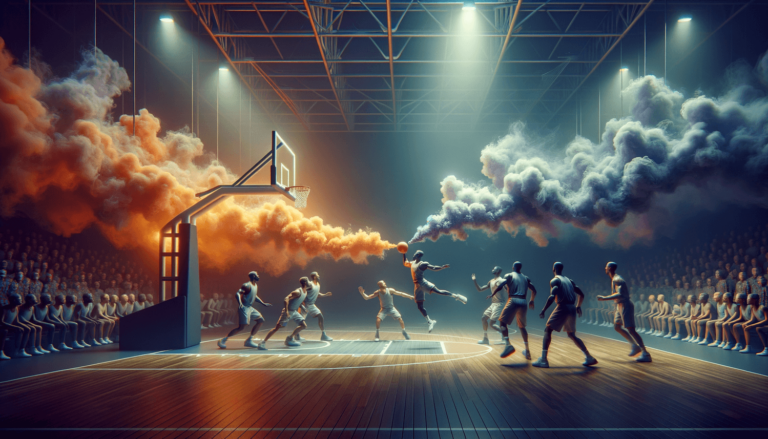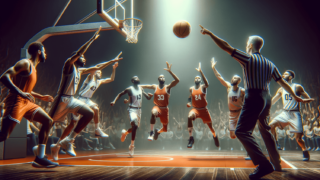
Restricted Area in Basketball: Rules and Interpretations
Written by: Basketball Universe
Last updated:

Welcome to the mesmerizing world of basketball, where even the smallest details can have a significant impact on the game! 🏀 Today we’ll dive deeper into an element that often leaves enthusiasts and newcomers alike scratching their heads: the mysterious ‘Restricted Area.’ Fear not, for we are here to unravel the secrets behind this enigmatic zone on the court. Together, we’ll explore its rules, interpretations, and significance to both offensive and defensive strategies. So brace yourselves, because you’re about to become well-versed in one of the most intriguing aspects of the game; the Restricted Area in basketball.
Restricted Area in Basketball: Rules and Interpretations
The Restricted Area, also known as the “no-charge semi-circle” or “no-charge zone,” is a semi-circular section on the basketball court located beneath the basket. This area is marked by a painted arc, measuring 4 feet from the center of the basket in NCAA games and 1.25 meters (4 feet 1.18 inches) in FIBA and NBA games. When an offensive player drives towards the basket, a defensive player cannot establish his position inside the Restricted Area to draw a player-control (charging) foul. If the defender is inside this zone and contact occurs, a blocking foul will be called on the defensive player, benefiting the offensive player. The purpose of this rule is to protect players from collisions under the basket and create a safer playing environment.
Uncovering the Origins of the Restricted Area
Before we delve into the nitty-gritty of how the Restricted Area functions and affects gameplay, let’s take a step back and discover how it came to be. Basketball has evolved considerably since Dr. James Naismith invented the sport in 1891, and the Restricted Area is one such innovation that has made the game safer and more strategic for players and fans alike. With roots stemming from NCAA men’s basketball competition in the early 1990s, the Restricted Area was adopted by the NBA in 1997 before eventually becoming embraced by FIBA (International Basketball Federation) in 2010.
Understanding the Geometry and Measurements
Now that we know a bit about its origins, it’s time to delve into the actual design and measurements of the Restricted Area. Check out these specifics that define the exact dimensions of this interesting zone on the court.
The Shape: A Clear Arc on the Court
The Restricted Area takes the form of a semi-circular arc, painted visibly on the court beneath the basket. This arc serves as a clear boundary between where a defender can and cannot legally draw a charging foul against an attacking opponent.
The Measurements: NBA, NCAA, and FIBA Differences
The size of the Restricted Area can vary slightly depending on the basketball organization. In NCAA games, the arc is placed 4 feet away from the center of the basket. For NBA and FIBA games, the arc measures 1.25 meters (4 feet 1.18 inches) from the center of the basket. It’s important to know the differences if you’re a fan or player involved with multiple organizations’ games.
The Rules: Key Regulating Principles
The Restricted Area plays a pivotal role in navigating the parameters of legal defensive moves. Brush up on these primary basketball rules to make sure you’re game-ready.
Blocking and Charging: A Delicate Balance
One of the most crucial aspects of the Restricted Area pertains to blocking and charging fouls involving the defender and the offensive player. A defensive player attempting to draw a charging foul must establish a legal guarding position outside the Restricted Area as the offensive player drives to the basket. If the defender fails to establish their position outside the Restricted Area and contact occurs, the referee will call a blocking foul on the defensive player. This distinction helps maintain a sense of fairness and order during intense moments on the court.
Exceptions: When the Restricted Area isn’t a Factor
Although the Restricted Area is a defining factor in many game situations, there are exceptions where it doesn’t come into play. One prominent example is if the offensive player has initiated a jump-stop or a spin-move within the three-second lane – in these cases, the Restricted Area loses its significance. Additionally, if the contact is deemed flagrant or unsportsmanlike, the Restricted Area is disregarded, and the referee will call a foul according to the severity of the situation.
The Strategies: Leveraging the Restricted Area for Success
Players and coaches can use the Restricted Area in clever ways to turn critical moments into game-winning opportunities. Here are some tactics you can employ to make the most of this unique zone on the court.
Attacking the Basket: Offense Finds its Way
Offensive players can use the Restricted Area to their advantage by driving aggressively towards the basket, challenging defenders, and potentially drawing fouls. If a defender fails to maintain a legal position outside the Restricted Area, an attacking player may be awarded free throws or possession of the ball, achieving critical points or a tactical advantage.
Protecting the Rim: The Art of Legal Defense
Meanwhile, defensive players should focus on establishing their position ahead of time outside the Restricted Area, forcing the offensive player into a charge. As a result, the defense can regain possession of the ball, turning the tide of the game with a well-timed and well-executed defensive maneuver.
Interpreting the Rules: Tips for Players, Coaches, and Fans
Comprehending how basketball rules apply to the Restricted Area is essential for players, coaches and fans. Learn more about how different interpretations of the rules can affect gameplay and help you gain a deeper understanding of the sport.
Staying Grounded: Defender’s Foot Position Matters
For a blocking foul to be called, the defender’s feet must be “inside” the Restricted Area at the moment of contact. If the defender has one foot inside and one foot outside the area, the foul will be deemed “outside,” and the call will depend on the players’ relative positions. Understanding this nuance can help players avoid foul troubles and enjoy a more successful defensive game.
Verticality: When Height Comes into Play
While the Restricted Area is a crucial determinant in calling fouls, it isn’t the only factor at play. Verticality – the concept of defenders making a play on a shot straight up without invading the offensive player’s space – is a crucial rule that works in tandem with the Restricted Area. Proper verticality supersedes the foul call within the Restricted Area, as long as the defender leaves their feet and maintains a straight up-and-down movement without leaning into the offensive player. This alignment of both factors can make or break critical plays during a game.
The Impact: How the Restricted Area Shapes the Game
Lastly, it’s important to recognize how the Restricted Area has shaped modern basketball and its approach to both offensive and defensive strategies. Let’s take a look at some key ways this semi-circular arc has left a lasting impact on the sport.
Increased Safety: Reducing Collision Injuries
One of the primary objectives of implementing the Restricted Area was to make the game safer for players. By dissuading defenders from crowding underneath the hoop, the chance of dangerous collisions and resulting injuries is significantly decreased.
Strategic Planning: Innovating Offensive and Defensive Approaches
The Restricted Area has also led to strategic innovation by transforming the way players approach the game. Offenses have adopted more drive-and-kick approaches, capitalizing on the limitations of the defenders within the Restricted Area. On the flip side, defensive players find new ways to contest the shots, relying on shot-blocking and agility to quickly cover the open man.
Tighter Referee Calls: Enhancing Fair Play
The implementation of the Restricted Area has also impacted the role of referees in the game. In high-pressure moments on the court, officials use the definitive arc as a reference when making difficult charging or blocking foul calls, adding clarity and fairness to the game.
As we’ve learned, the Restricted Area greatly influences basketball rules, strategies, and outcomes. By gaining a comprehensive understanding of this crucial aspect of the game, both players and fans can appreciate the sport’s intricacies and thrive in a fast-paced, ever-evolving basketball landscape.
Frequently Asked Questions about the Restricted Area in Basketball
Understanding the Restricted Area can be a challenging task for even seasoned basketball enthusiasts. To enhance your expertise on the topic and better comprehend the intricacies of the game, let’s address some common questions surrounding the Restricted Area in basketball.
What’s the purpose of the Restricted Area?
The primary purpose of the Restricted Area is to enhance player safety by minimizing risky collisions near the basket. By discouraging defenders from taking charges close to the hoop, the risk of injury to both the offensive and defensive players is reduced. Furthermore, the Restricted Area brings clarity to referees when they are making decisions on charging and blocking fouls, ensuring fair and consistent judgments during gameplay.
How can players use the Restricted Area to their advantage in a game?
Offensively, players can use the knowledge of the Restricted Area to drive to the basket confidently and potentially draw fouls, earning opportunities for free throws. Defensively, awareness of the Restricted Area can help players strategically establish their position outside the arc, increasing the chances of drawing a charging foul and potentially regaining possession of the ball.
Can defenders draw charges if they’re touching the Restricted Area line?
A defender who has one foot touching the Restricted Area line is technically considered “inside” the Restricted Area. In such cases, the referee will use their judgment in determining whether a charge or a blocking foul should be called. Players should aim to establish their position completely outside the Restricted Area line to maximize the chance of a positive outcome.
Does the arc of the Restricted Area affect the three-point line and vice versa?
While both the arc of the Restricted Area and the three-point line are relevant markings on the court, they are distinct from each other and serve different purposes in the game. The Restricted Area is used for defensive charge or block calls, while the three-point line determines the point value of a successful shot.
What happens if both players on offense and defense violate the rules at the same time?
If both offensive and defensive players break the rules simultaneously in the Restricted Area, referees will use their discretion to determine which player committed the more severe infraction or if a double foul should be called. The situation may vary depending on the specific actions of the players and their positions on the court.
With this deeper understanding of the Restricted Area in basketball, you can better appreciate the strategic nuances and safety measures that contribute to making the sport exciting, stimulating, and fair for both players and fans alike. Happy hoops!
FAQ: In-Depth Knowledge on the Restricted Area
Expand your comprehension of the Restricted Area in basketball with this comprehensive list of frequently asked questions. From technicalities to strategic insights, this FAQ section covers the most common queries about this vital court element.
1. Is the Restricted Area exclusive to professional basketball levels?
No, the Restricted Area is not exclusive to professional levels. It is present in various basketball organizations, including NCAA, NBA, and FIBA games.
2. Are there any differences in the size of the Restricted Area across basketball organizations?
Yes, the size of the Restricted Area varies across basketball organizations. In NCAA games, the arc is 4 feet from the center of the basket, while in NBA and FIBA games, it measures 1.25 meters (4 feet 1.18 inches) from the center.
3. Can a defender draw a charging foul if they have one foot inside the Restricted Area and one foot outside?
If a defender has one foot inside and one outside the Restricted Area, they are considered “inside” the arc. In this case, the referee will use their judgment to determine whether a charge or blocking foul should be called based on the players’ relative positions.
4. What defines a “legal guarding position”?
A legal guarding position is established when the defender has both feet on the floor, facing the offensive player, and is stationary or moving backwards/alongside their opponent. By obtaining this position, defenders can legally attempt to draw a charge.
5. Are there any exceptions to the Restricted Area rule?
Yes, there are exceptions to the Restricted Area rule. For example, if the offensive player initiates contact with a jump stop or spin move within the three-second lane, or if the contact is flagrant or unsportsmanlike, the Restricted Area loses its significance and the referee will call a foul based on the severity of the situation.
6. How does verticality come into play with the Restricted Area?
Verticality is the concept of defenders attempting to block shots by jumping straight up without invading the offensive player’s space. Proper verticality supersedes the foul call within the Restricted Area, as long as the defender leaves their feet and maintains a straight up-and-down movement without leaning into the offensive player.
7. What happens if there is a double foul in the Restricted Area?
If both offensive and defensive players commit fouls simultaneously in the Restricted Area, the referee will use their discretion to determine which player committed the more severe infraction or if a double foul should be called. In the case of a double foul, each player is assessed a personal foul and no free throws are awarded. The team that had possession before the fouls occurred will retain possession.
8. Does the Restricted Area affect a player’s decision to take a charge vs. attempt a block?
Yes, the Restricted Area may affect a player’s decision to take a charge or attempt a block. Defenders outside the arc are more likely to take a charge, while defenders within the Restricted Area will attempt to block shots using verticality to minimize the risk of a blocking foul.
9. How has the Restricted Area impacted modern basketball?
The Restricted Area has significantly impacted modern basketball by increasing player safety through the reduction of dangerous collisions and promoting strategic innovation at both offensive and defensive ends. It has also made the referees’ job easier by providing a clear reference for making charge and block calls.
10. Can the offensive player also be called for a foul within the Restricted Area?
Yes, the offensive player can be called for a foul within the Restricted Area if they commit an offensive foul (push off, illegal screen, etc.) or if their contact is deemed flagrant or unsportsmanlike. In these cases, the significance of the Restricted Area is disregarded, and the call will be based on the type and severity of the infraction.
Featured Posts
- No pillar pages found.





